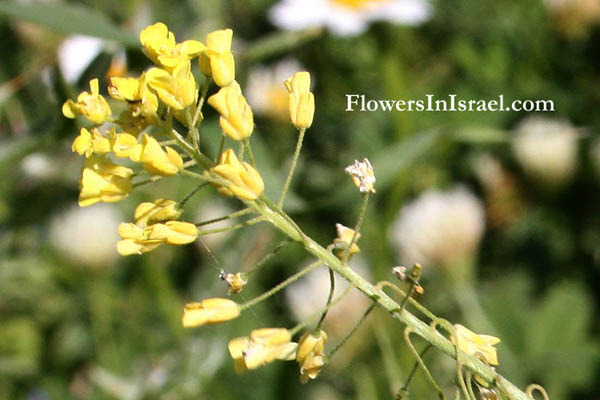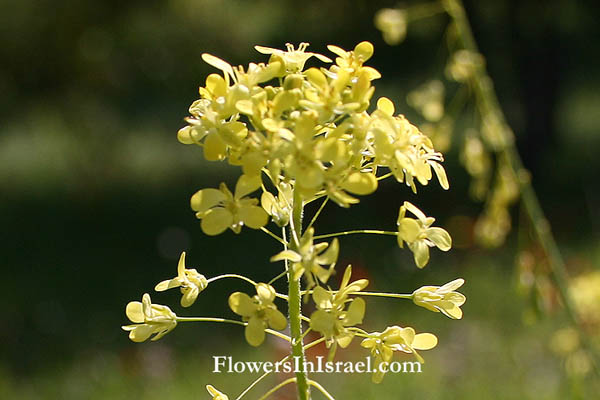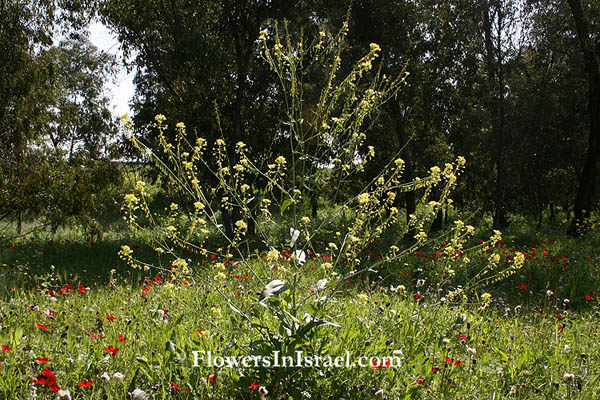Hebrew: איסטיס מצוי, Arabic: الوسمة البرتغالية
| Scientific name: | Isatis lusitanica L. | |
| Synonym name: | Isatis aleppica Scop. | |
| Common name: | Aleppo Woad | |
| Hebrew name: | איסטיס מצוי | |
| Arabic name: | الوسمة البرتغالية | |
| Family: | Cruciferae / Brassicaceae, מצליבים |

|
| Life form: | Annual | |
| Stems: | Up to 40-60cm; erect, glabrous or hispid below | |
| Leaves: | Alternate, entire | |
| Flowers: | Yellow | |
| Fruits / pods: | Siliqua; pendant, linear-oblong | |
| Flowering Period: | March, April, May | |
| Habitat: | Batha, Phrygana | |
| Distribution: | Mediterranean Woodlands and Shrublands, Semi-steppe shrublands, Shrub-steppes, Deserts and extreme deserts, Montane vegetation of Mt. Hermon | |
| Chorotype: | Med - Irano-Turanian | |
| Summer shedding: | Ephemeral |

Derivation of the botanical name: Isatis, the classical Greek name isatis applied to this herb, which provided the blue dye, which ancient Britons used to stain their bodies. lusitanica, of or from Portugal (Lusitania), Portuguese. aleppica, of or from Aleppo, in northwestern Syria. The Hebrew name: איסטיס, Isatis, transliteration from the scientific name.
Chazal (literally "Our Sages, may their memory be blessed"), mentioned isiatis, as similar to Tekhelet, and identified it with the Arabic neel. Tekhelet (Hebrew: תכלת ) is the Hebrew transliteration for the word “blue” describing a specific dye to be used in the Temple of God and on the garments of his people. This blue dye is mentioned 48 times in the Bible but was translated as hyakinthinos (Greek: ὑακίνθινος, blue ) by the Septuagint version of the Bible. The uses of the dye included the clothing of the High Priest, the tapestries in the Tabernacle (Mishkan), and a thread, or threads, on the corner tassels of the tallit (prayer shawl). The Talmud states that tekheleth is indistinguishable from kala-ilan. In fact kala-ilan is the Talmudic name for indigo which seems to be derived from the Sanskrit kala and the Aramaic ilan = tree in view of the fact that the indigo plant often attains the height of 2m it could popularly be called a tree. Rabbi Ovadia of Bartenura (1465 - c. 1515) to tractate Kilayim chapter 2, mishna 5 wrote on the word Isatis: "Its color resembles Tekhelet and they call it in Arabic by the name Neel and in a different foreign language by the name 'Indico' . And it is usual to cut it and it grows back again, and what grows back the second time is called 'Sefiach' ". Rabbi Moshe Ben Maimon, Maimonides, Rambam (1135 - 1204) recounts Isatis as an example of a substitute for Tekhelet: "And all that is not dyed with that type of dye is invalid for Tzitzit even though it has the appearance of the sky, for example, that they dyed it with Isatis or other dark dyes - behold it is invalid (Hilchot Tztitzit 2:1). And it is reasonable to assume that he didn't use the expression of the Talmud, Kala Ilan, for in Rambam's time they called the source for the forgery of Tekhelet by the name of Isatis. The Rambam does seem to use isatis in place of kala ilan. Most probably the two were associated with different plants which both produced the same dye (indigo). Isatis referred to the woad plant, while kala ilan corresponded to Indigofera tinctoria which was cultivated in warmer climates (specifically China and India) and yields much higher concentrations of indigo. 
|